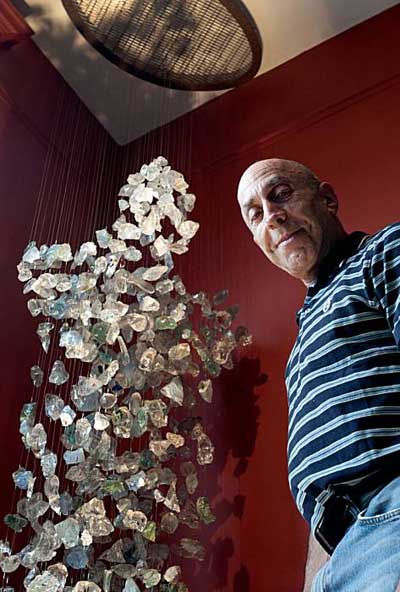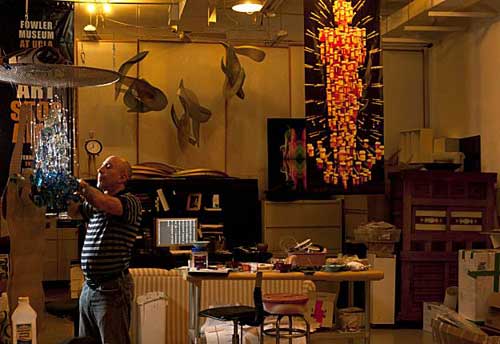
 Sculpture News at SculptSite.com
Sculpture News at SculptSite.com
Daniel Goldstein Haunting Ghost Sculpture |
| SFGate.com by Charlie Wells He had a fast rise. Fresh out of art school, he had a trendy studio in San Francisco. He had gallery displays on Fifth Avenue in Manhattan and curators clamoring over him. He had his own print exhibit at one of the largest museums in the country. Then in a few years, Daniel Goldstein found out he had something else: a death sentence. It was the early '80s in San Francisco, and AIDS was ravaging the city. It killed Steve Richards, Goldstein's partner of 10 years. Then it killed just about everyone else the young artist knew. Yet somehow, Goldstein survived. Not long after his diagnosis, he ditched his successful career as a woodblock printer. He plunged into a new medium, one that would haunt thousands across the globe. Daniel Goldstein started making ghosts. It's tedious work. "But it's meditative, it's therapeutic," Goldstein says. "It's also nice to wake up in the morning and know exactly what I'm going to do." Ethereal, translucent and moving, Goldstein's ghosts are sculptures. They are, for the most part, huge mobiles suspended from the ceiling and made from all sorts of things: glass, mesh, medicine bottles. They shimmer and glisten. They look, vaguely, like people. Gazing up at one hovering in the corner of his Mission District loft, the artist recalls that just two years after art school, he was emerging as the next big thing in print. His prints, kind of like Japanese woodblocks, showed serene, minimalist rooms with windows opening onto similarly minimalist landscapes. By 1983, Goldstein had his own show at the Brooklyn Museum, the second-largest museum in New York City. The one-man show opened before his biggest audience yet. Acclaimed critic Richard Howard praised Goldstein for combining seemingly contradictory impulses in American art: an aim for emptiness with an establishment of subjectless ecstasy. By this point the artist had a staff of three. His prints were selling fast. It was all so easy. He knew. Even before his partner took both their blood samples to the lab in the summer of 1984, Goldstein knew what was hiding in the vials. Richards, his partner, was an immunological researcher working for Jay Levy at UCSF, one of the first doctors to isolate and identify HIV. Goldstein heard the news in the loft, in the same room where one of his ghosts hangs today. The thought shot through the printmaker's brain as the diagnosis was read. If he was going to die, he needed to be a sculptor first. "I have so many sculptures in my head," he remembers thinking. Woodblock prints had only been sort of a secondary path; sculpture was what he'd studied for years. Back in 1965, a much younger Goldstein was on a bicycle pedaling through New York City's West Side. At Lincoln Center, he spotted Alexander Calder, the internationally renowned kinetic sculptor most famous for his abstract mobiles. Colorful things, they're minimalist and free moving. Goldstein had already been experimenting with similar designs, and Calder was his idol. Nervously, the teen approached Calder, who happened to be installing a piece - "Le Guichet" - outside the Vivian Beaumont Theater. They really only exchanged a few short words, but the kid was so excited. Richards died in the winter of 1986. Eight months later, Goldstein finally felt strong enough to work again. Still, some of the treatments made him feel as if he'd been hit by a truck. The doctors expected him to live only a few more years, so he sculpted. He started making objects he calls reliquaries. They were towers with moving parts and completely permeable spaces, slightly mysterious and always changing. He made one for each of his friends killed in those early years. "They were like ghost houses," he says. Later, in the early '90s, Goldstein premiered a series of sculptures that also latently memorialized those who had died early from AIDS. The pieces were essentially found art, leather coverings of the equipment at the Muscle System, a gym that Goldstein frequented in the Castro. Well worn and sweat stained by the men who pressed against them daily, the pieces looked like tribal leatherwork from an ancient age. He called them "The Icarian Series," named after the brand of machines from which the leather came. (Ironically, Icarus was the youth from Greek mythology who fell to his death after flying too close to the sun.) For the first time since switching to sculpture, Goldstein began to attract the attention of critics. But artful dedications to the dead didn't pay the bills. Aside from the "Icarian" showings at several galleries and museums scattered across the country, Goldstein's new path meant giving up the glitzy museum and gallery shows that in his younger years had made him feel a little bit like a celebrity. Instead, he was making enormous hanging sculptures for public spaces, hospitals, even the Colma BART Station. They were still artful, but weren't really the things galleries show. And because of their size, they couldn't be easily shown in museums. "It's hard to straddle the commercial world and the fine arts world," says Jason Lahman, Goldstein's current partner, who has developed an encyclopedic knowledge of Goldstein's career. That doing something he loved meant giving up the glamour was bittersweet, according to Lahman, who says he thinks Goldstein isn't as well known in fine arts circles as he should be. But Lahman thinks that's about to change. This summer, a set of Goldstein's arresting new sculptures was on display at the International AIDS Conference in Vienna. Anyone who's anyone in AIDS research shows up for these biennial meetings, and the artist's work was the undisputed visual focal point. Goldstein feared that because the hall was so huge, the exhibit might not work. "It was the size of an airplane hangar," he recalls. But Mats Ahnlund, the acting executive director of the International AIDS Society, says that with 20,000 left-brained researchers swarming the place, the sculptures created an emotional intensity that would have been impossible to express through charts and graphs. "Through the works people don't only rationally feel that AIDS research is an important thing, but they can also see that it's important, feel that it's important with the other part of the brain," he says. One piece was made into a loosely human form out of hundreds of the artist's HIV pill bottles; he'd been collecting them since the early '90s. Another figure was made from the chunky white bottles of South African pills. The third hung like an invisible man outlined in clear syringes. They floated like translucent wraiths before a black curtain at the back of the enormous hall. "I always say I live in a world of ghosts, because so many of my friends, my whole world, all the people I came out with, everybody - except for one or two people - they're all dead," Goldstein says. Casting off an old career, diving into a risky new medium he loved, it helped keep him alive in the midst of so much loss. "I would have lost my mind," he says. "Doing the sculptures was all I could do." |
 A talented artist/sculptor who never quits... Daniel creates sculpture both hanging and kinetic - some really nice work with thought and message! The Presence of Absence goes a long way in making "The Invisible Man", Made for the 2010 Vienna AIDS Conference. To see videos of Daniel Goldstein's work, go to youtube.com/user/GoldsteinStudio. Thank you to Charlie Wells for a great read and telling us the riveting story of Daniel Goldstein. |
 Sculptor Daniel Goldstein |
 |
| Daniel Goldstein works in his San Francisco studio. Behind him is an image of "Medicine Man," a sculpture displayed at the International AIDS Conference. |
More Sculpture News ....
Submit your SCULPTURE NEWS.
It's easy, just send us an e-mail
(click on Submit News in the left menu) with your pertinent information along with images, we'll take care of the rest. Sculpture makes our world a much better place in so many ways!
SculptSite.com, along with Sculptors and their creative genius all helping to bring the beauty and message of Sculpture to a hurried world.

